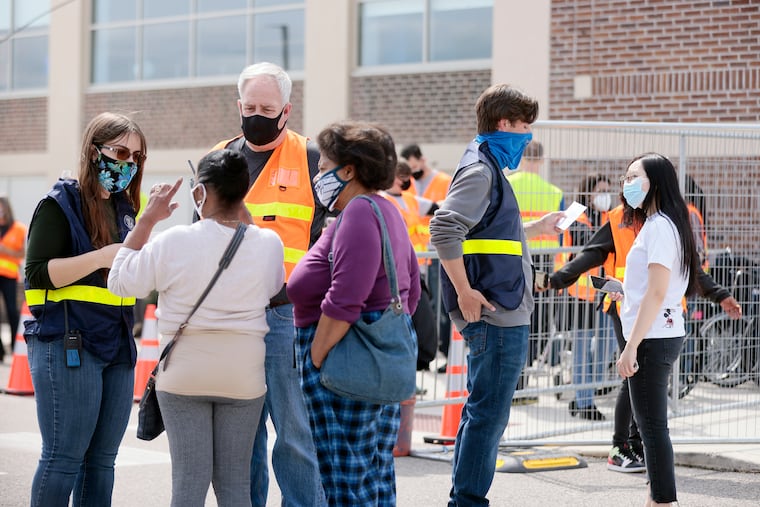To vaccinate more Latino Philadelphians, community-led clinics are key | Opinion
Talking to my mom about her own vaccine fears helped me understand lasting vaccine concerns.

My mom always made sure my little sister and I received all our vaccinations. She taught us the importance of getting vaccinated as a way of keeping ourselves and our community safe. So when she told me in early March that she didn’t want to receive the COVID-19 vaccine, I was shocked. I never expected my mom to be one of many Hispanic adults hesitating to get vaccinated.
Vaccine hesitancy has been discussed time and again by health-care professionals since the beginning of the vaccine rollout. While hesitancy isn’t unique to any particular group of people, its effects are most damaging to communities of color that are already struggling to access vaccines. As eligibility requirements expand, and shots reach more Americans, vaccine hesitancy remains a pressing issue among Hispanic and Latino communities. And it will be a lasting one, since the Pfizer and Moderna vaccines may need a follow-up booster shot.
» READ MORE: Vulnerable immigrants in Philly are scrambling to get the COVID-19 vaccine with few resources or outreach
When I asked my mom why she didn’t want to receive the vaccine, she said the quick development and release seemed suspicious. Despite my explaining why the mRNA vaccines were developed so quickly and disproving misinformation around them, my mom insisted that she didn’t want to receive it until the end of the rollout to ensure it was safe.
Although I was initially confused, after some reflection, I understood why she, and other people of color, are hesitating. After decades of being ignored, mistreated, and exploited by the health-care system, it makes sense for people of color to be cautious of novel health interventions. That makes it all the more urgent for health officials to find ways of addressing the concerns of these communities — not just opening more vaccine clinics, but also working with the community to address hesitancy.
The desire to “wait and see” is one shared by many Latino people experiencing hesitancy. A Kaiser Family Foundation poll published in late March found that while the share of adults wanting to “wait and see” how the vaccine works has shrunk over the last four months, 18% of Hispanic adults said they still want to “wait and see” before getting it themselves.
These findings are important in Philadelphia, as the delay in vaccination among Hispanic adults could severely impact how quickly we reach herd immunity. When we consider that Hispanic individuals make up 15.2% of the Philadelphia population, and only 17% have received their first dose as of the week of April 5, the 18% figure becomes more troubling. If we look further at the hesitancy, we find reasons ranging from conspiracy theories to the historical legacies of exploitation to simply not having enough information. To address these issues in these crucial months of vaccine rollout, public health officials need to invest more time and money into messaging campaigns, peer-to-peer outreach efforts, and clinics that directly reach Latino communities.
» READ MORE: I don’t mistrust vaccines. I mistrust government distribution. | Opinion
While we’re starting to see targeted messaging campaigns gaining attention, like Univision and FactCheck.org receiving funding to tackle vaccine misinformation in Hispanic communities, more should be done at the local level. In Philadelphia, for example, organizations like the South Philly-based Juntos and Puentes de Salud — whose education program I volunteer with, and where I’ll soon help set up vaccine appointments — are using their social media platforms and direct relationship with Latino communities to provide accurate vaccine information and secure appointments. And the Esperanza Community Vaccination Center in North Philly has vaccinated a majority of Hispanic community members.
The work of these organizations is ensuring that our most vulnerable community members, like undocumented immigrants, have access to bilingual information, feel comfortable, and are best able to receive the vaccine given their specific barriers to access (long work hours, lack of ID, fear of documentation, etc.). If public health officials and local governments invest more resources into community-led efforts, we can address issues of misinformation, government distrust, and lack of information directly.
» READ MORE: Lack of targeted outreach, translated materials leaves Latino community behind as Pa. struggles with vaccine rollout
While many people, like my mother, are unsure about getting the COVID-19 vaccine, I know that the work of community-based organizations has helped many get answers to their questions and feel comfortable being vaccinated. If we want to reach herd immunity, we can’t simply tell Latino communities that they need to get vaccinated. We need to address all of their concerns by working directly with them.
Wendy Lliguichuzhca is a volunteer with Puentes de Salud and an undergraduate at the University of Pennsylvania studying health and societies.